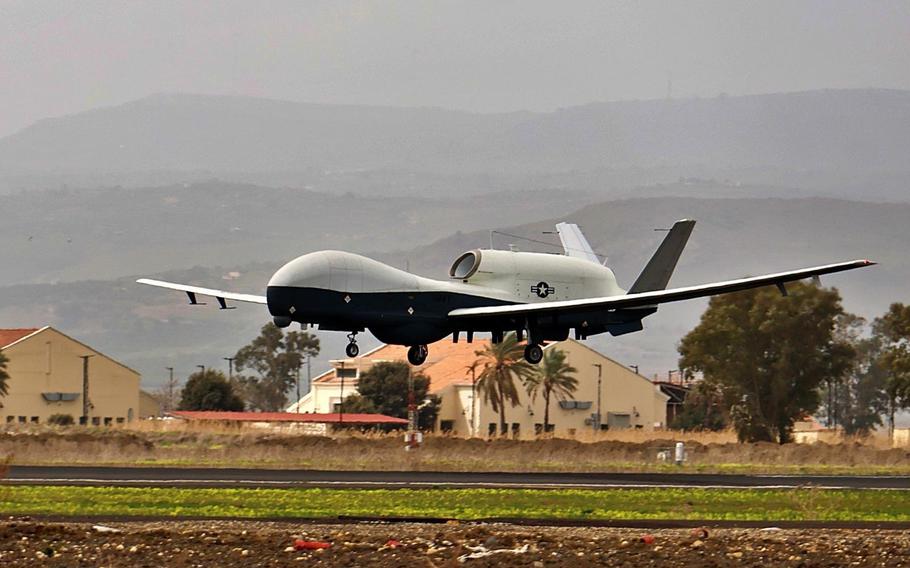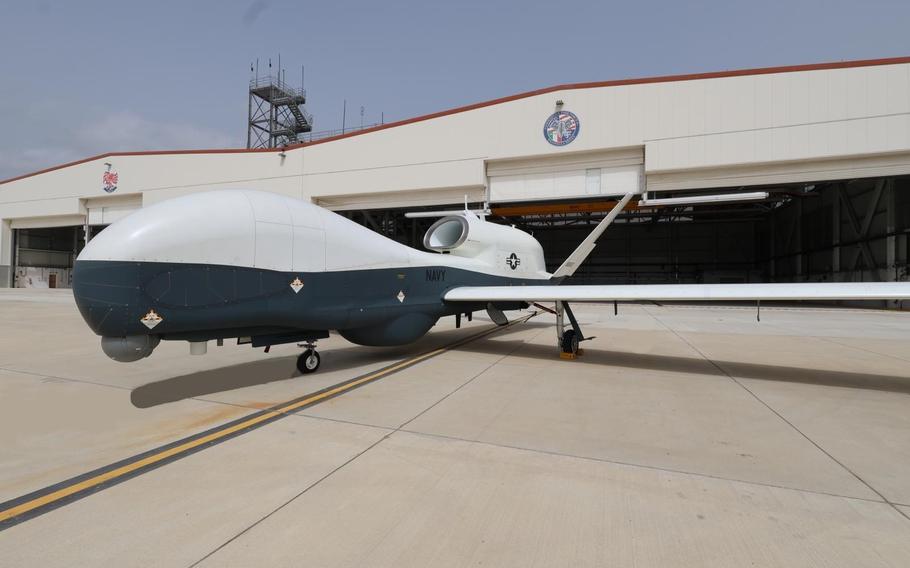
The first MQ-4C Triton arrives at Naval Air Station Sigonella, Italy, March 30, 2024. The Triton's basing in the U.S. 6th Fleet area of operations establishes the second global detachment of Unmanned Patrol Squadron 19. (U.S. Navy)
NAPLES, Italy — One of the U.S. military’s newest intelligence drones has arrived in Europe as part of the only Navy unmanned patrol squadron’s second detachment.
An MQ-4C Triton drone arrived at Naval Air Station Sigonella on Saturday, the Navy announced in a statement the same day.
Last month, VUP-19 celebrated the deployment of a detachment and opening of a Triton hangar at the base in Sicily. The squadron also has a detachment in Guam.
Bringing the Triton to the U.S. 6th Fleet area of responsibility expands “the roles of unmanned aircraft systems operations in our region and beyond,” Capt. Aaron Shoemaker, commanding officer of NAS Sigonella, said in the statement.
NAS Sigonella’s location in the Mediterranean enables deployment of P-8 Poseidon patrol and reconnaissance aircraft throughout the theater, supporting U.S. European Command and U.S. Africa Command.
The drone, which is designed to work with the P-8 Poseidon, can aid intelligence gathering, support search and rescue operations and serve as a communications relay.
It wasn’t clear how many Tritons eventually would be based at Sigonella. A drone’s five-member crew per ground station comprises a pilot, tactical coordinator, two mission payload operators and a foreign signals intelligence coordinator, according to the Navy.

The first MQ-4C Triton arrived at Naval Air Station Sigonella, Italy, March 30, 2024. The Triton's basing in the U.S. 6th Fleet area of operations establishes the second global detachment of Unmanned Patrol Squadron 19, while the other is in Guam. VUP-19 is homeported at Naval Air Station Jacksonville and Naval Air Station Mayport in Florida. (U.S. Navy)
The VUP-19 detachment at the base includes 43 maintainers, three pilots and an officer-in-charge, said Lt. j.g. Andrea Perez, a base spokeswoman. She added those numbers would change in the next month or so when more squadron personnel arrive.
The detachment will have regular six-month rotations every April and October, Perez said.
In its 2024 budget, the service reduced the number of Tritons it planned to purchase from 70 to 27 due to a Joint Requirements Oversight Council reassessment, according to the Navy budget documents.
That reduction also saw the gross cost of the Triton rise nearly 25% from $194.7 million in 2023 to about $243.2 million per drone in 2024 due to buying fewer units, according to the budget documents.
The JROC reassessment also reduced the number of Triton deployment sites from five to three, Seapower Magazine reported in May 2023. It’s not clear where a third detachment would be located but earlier contenders included Whidbey Island, Wash., and a base in the U.S. Central Command area of responsibility, according to the Seapower report.
VUP-19 is homeported at Naval Air Station Jacksonville and Naval Air Station Mayport in Florida.
As of September, five Tritons had been delivered to the Navy, Northrop Grumman, the drone’s maker, said in a Sept. 14 statement. Navy 2024 budget documents account for 22 drones in production with another five in development.
The drone reached initial operating capability in September, clearing the way for the Triton to ease into operations in the U.S. Indo-Pacific Command.
The Israel-Hamas war on the edge of the eastern Mediterranean, Russian threats in the Baltics and the war in Ukraine have brought sharper focus on the European theater more than at any time in decades. The Navy also partners with African nations to combat extremist militants and protect sea lanes.
The U.S. Naval Forces Europe-Africa/U.S. 6th Fleet area of operations covers half of the Atlantic Ocean, from the Arctic Ocean to the coast of Antarctica, including all of Europe and Russia, and most of Africa.